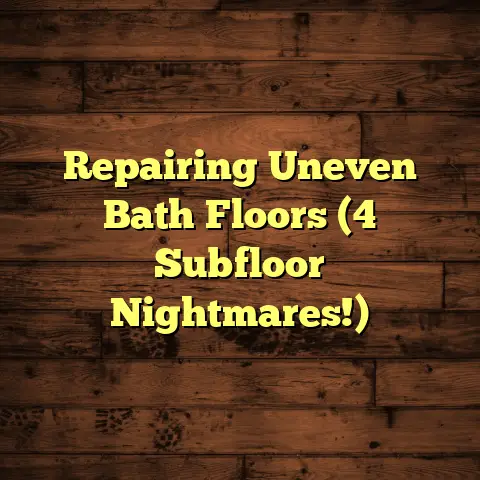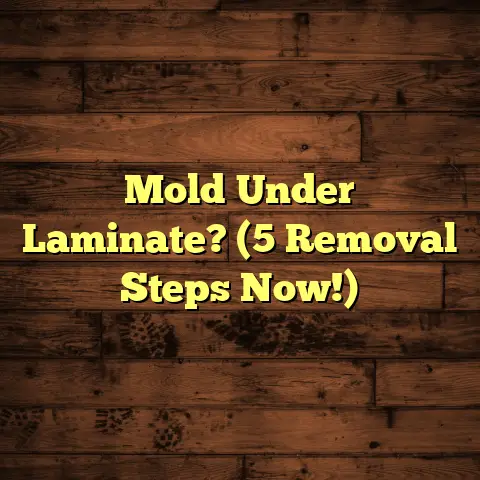How To Power Wash Garage Floor? (2 Pro Tips!)
Think clean, organized, and maybe even a little stylish. A big part of achieving that is having a sparkling clean garage floor. And that’s where power washing comes in.
Power washing your garage floor isn’t just about aesthetics; it’s about creating a functional and inviting space. It’s a trend that’s gaining serious traction, and for good reason.
I’ve seen firsthand how it can transform a dingy, oil-stained floor into something that looks almost brand new. So, let’s dive into how you can achieve this yourself!
Section 1: Understanding Power Washing
So, what exactly is power washing? Well, it’s not just your regular garden hose. It’s using a machine to blast water at high pressure. This pressure is measured in PSI (pounds per square inch).
Think of it as a super-charged cleaning method that goes way beyond what a brush and bucket can do.
A standard garden hose might deliver water at around 40-60 PSI. A power washer, on the other hand, can range from 1500 PSI for light-duty cleaning to over 3000 PSI for heavy-duty tasks.
The key is the force of the water. This force dislodges dirt, grime, and even stubborn stains that have been embedded in your garage floor for years.
Now, why is power washing so great for garage floors? Simple: it’s incredibly effective. Garages are notorious for collecting all sorts of gunk.
- Oil spills? Check.
- Road salt? You bet.
- Grime and dirt tracked in from your car? Absolutely.
According to a study by the National Association of Home Builders, a clean and well-maintained garage can actually increase your home’s resale value. While they don’t specifically mention power washing, it’s a crucial part of that maintenance.
Power washing not only removes these unsightly stains but also helps prevent long-term damage to your garage floor. This is especially important for concrete floors, which can be porous and susceptible to absorbing contaminants.
Section 2: Preparing for the Power Washing Process
Before you even think about firing up that power washer, you need to prep. Trust me; skipping this step is a recipe for disaster.
First and foremost: safety. Water and electricity are a dangerous combination.
- Wear safety glasses: Flying debris is a real concern.
- Gloves: Protect your hands from chemicals and the force of the water.
- Closed-toe shoes: No sandals!
- Cover any electrical outlets: Use plastic sheeting and tape.
- Turn off the power to the garage: If possible, just to be extra safe.
Next, think about the environment. You don’t want to be washing all that grime down the storm drain.
- Check your local regulations: Some areas have restrictions on wastewater disposal.
- Consider using a wet/dry vacuum: To collect the dirty water and dispose of it properly.
- Use eco-friendly cleaning solutions: Biodegradable options are available.
Now, let’s talk about the tools you’ll need:
| Tool | Recommendation |
|---|---|
| Pressure Washer | Electric (1600-2000 PSI) for most garage floors; Gas-powered (2000-3000 PSI) for heavily stained floors. |
| Nozzles | 25-degree nozzle for general cleaning; 40-degree nozzle for rinsing; Soap nozzle for applying detergent. |
| Cleaning Solution | Concrete cleaner/degreaser; Look for biodegradable options. |
| Broom/Shop Vac | For removing loose debris before washing. |
| Stiff-Bristled Brush | For scrubbing stubborn stains. |
| Buckets | For mixing cleaning solutions. |
| Squeegee | For helping to dry the floor quickly. |
| Protective Gear | Safety glasses, gloves, closed-toe shoes. |
Finally, assess your garage floor. Is it bare concrete? Is it coated with epoxy? Is it tile?
- Concrete: Can handle higher pressure, but be careful not to damage the surface.
- Epoxy: More delicate; use lower pressure and a mild detergent.
- Tile: Be mindful of the grout; use a grout brush to pre-clean if necessary.
Knowing your floor type will help you choose the right cleaning solution and pressure settings.
Section 3: Step-by-Step Guide to Power Washing Garage Floors
Okay, you’re prepped, you’re ready, let’s get down to the nitty-gritty. Here’s a step-by-step guide to power washing your garage floor like a pro:
Step 1: Clearing the Area
This might seem obvious, but it’s crucial. Remove everything from your garage floor. I mean everything.
- Cars: Park them outside.
- Tools: Shelves, workbenches, toolboxes – move them all.
- Storage bins: Stack them neatly out of the way.
The goal is to have a completely clear, unobstructed surface to work with. This will not only make the power washing easier but also prevent you from accidentally damaging your belongings.
Step 2: Pre-Cleaning
Before you unleash the power of the water, sweep the floor thoroughly. Use a stiff-bristled broom or a shop vac to remove any loose debris, dirt, leaves, or cobwebs.
This step prevents the power washer from simply blasting the debris around and potentially clogging the drain. It also helps the cleaning solution penetrate the stains more effectively.
Step 3: Applying Cleaning Solution
Now it’s time to bring in the chemicals. Choose a cleaning solution specifically designed for garage floors. Look for a concrete cleaner/degreaser.
- Follow the manufacturer’s instructions: Dilute the solution as directed.
- Apply the solution evenly: Use a pump sprayer or a mop to coat the entire floor.
- Let it dwell: Allow the solution to sit for 5-10 minutes to loosen the grime.
For particularly stubborn stains, you might need to use a concentrated solution or a dedicated stain remover. Apply it directly to the stain and let it sit for a bit longer before power washing.
Step 4: Power Washing Technique
This is where the magic happens. But it’s also where you need to be careful.
- Start with a low pressure setting: You can always increase it if needed.
- Use a 25-degree nozzle: This provides a good balance of cleaning power and coverage.
- Hold the nozzle at a 45-degree angle: And about 12-18 inches from the surface.
- Use overlapping strokes: Work in a consistent pattern, like you’re mowing the lawn.
- Keep the nozzle moving: Don’t hold it in one spot for too long, or you could damage the surface.
For heavily stained areas, you might need to make several passes with the power washer. Use a back-and-forth motion, and gradually increase the pressure if necessary.
Step 5: Rinsing and Drying
Once you’ve power washed the entire floor, it’s time to rinse away the dirty water and cleaning solution. Switch to a 40-degree nozzle for a wider spray pattern.
- Rinse thoroughly: Make sure to remove all traces of the cleaning solution.
- Use a squeegee: To push the water towards the drain.
- Allow the floor to dry completely: Open the garage door and windows to improve ventilation.
Drying time will depend on the weather and humidity. It could take a few hours or even overnight.
Step 6: Post-Cleaning Care
After the floor is dry, inspect it for any remaining stains. If you find any, you can try spot-treating them with a stain remover and scrubbing with a stiff-bristled brush.
You might also consider applying a concrete sealer to protect the floor from future stains and damage. This is especially important for bare concrete floors.
Section 4: Pro Tips for Successful Power Washing
Okay, now for the insider secrets. Here are two pro tips that can take your power washing game to the next level:
Pro Tip #1: Choosing the Right Time for Power Washing
Timing is everything. The best time to power wash your garage floor is on a warm, dry day.
- Avoid extreme heat: The cleaning solution can dry too quickly, making it less effective.
- Avoid rain: Obviously, rain will just dilute the cleaning solution and make it harder to dry the floor.
- Aim for a temperature between 60-80°F (15-27°C): This is the sweet spot for optimal cleaning and drying.
Also, consider the time of day. Morning is usually a good choice because the sun hasn’t had a chance to heat up the floor too much.
Pro Tip #2: Maintaining Your Garage Floor After Power Washing
Power washing is a great start, but it’s not a one-and-done solution. To keep your garage floor looking its best, you need to maintain it regularly.
- Apply a concrete sealer: This will protect the floor from stains, water damage, and wear and tear. Look for a penetrating sealer that will soak into the concrete and create a barrier.
- Clean up spills immediately: Don’t let oil, grease, or other liquids sit on the floor for too long. Wipe them up as soon as possible.
- Use mats or rugs: To protect high-traffic areas from dirt and wear. Place mats under your car, workbench, and other areas where you spend a lot of time.
- Sweep regularly: To remove loose debris and prevent it from grinding into the floor.
Consider using a product like Quikrete Concrete & Masonry Waterproofing Sealer. It’s a popular choice among homeowners and contractors for its ease of application and effectiveness.
According to product reviews on websites like Home Depot, this sealer can last for several years, providing long-lasting protection for your garage floor.
Conclusion
So, there you have it. A comprehensive guide to power washing your garage floor like a pro. It might seem like a lot of work, but trust me, the results are worth it.
A clean, well-maintained garage floor not only looks great but also adds value to your home and makes your garage a more enjoyable space to work and store your belongings.
Remember, power washing is a powerful tool, but it’s important to use it safely and responsibly. Follow the steps outlined in this article, and you’ll be well on your way to a garage floor that you can be proud of.
Don’t let your garage be the forgotten zone. Take pride in your space, and make power washing a regular part of your home maintenance routine. You’ll be amazed at the difference it makes!





